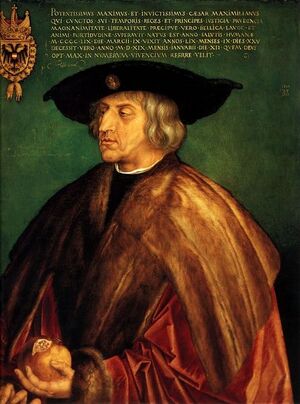No edit summary |
m (clean up, typos fixed: Succeded → Succeeded) |
||
| Line 1: | Line 1: | ||
| − | [[Image: |
+ | [[Image:Maximilian I Austria.jpg|thumb|300px|right]] |
'''Maximilian I''' (1459 - 1519) was the [[Holy Roman Empire|Holy Roman Emperor]], King of [[Germany]], Archduke of [[Austria]], Duke of [[Styria]] and [[Carinthia]], and Margrave of [[Carniola]] from 1493 until 1519, and the Count of the [[Tyrol]] from 1490 until 1493. |
'''Maximilian I''' (1459 - 1519) was the [[Holy Roman Empire|Holy Roman Emperor]], King of [[Germany]], Archduke of [[Austria]], Duke of [[Styria]] and [[Carinthia]], and Margrave of [[Carniola]] from 1493 until 1519, and the Count of the [[Tyrol]] from 1490 until 1493. |
||
| Line 21: | Line 21: | ||
Maximilian I |
Maximilian I |
||
!width=150px| |
!width=150px| |
||
| − | + | Succeeded by: |
|
|- align="center" |
|- align="center" |
||
|[[Frederick V of Austria|Frederick III]] |
|[[Frederick V of Austria|Frederick III]] |
||
Revision as of 21:33, 21 December 2013

Maximilian I (1459 - 1519) was the Holy Roman Emperor, King of Germany, Archduke of Austria, Duke of Styria and Carinthia, and Margrave of Carniola from 1493 until 1519, and the Count of the Tyrol from 1490 until 1493.
Maximilian was born in Wiener Neustadt on 22 March 1459 as the son of Emperor Frederick of Habsburg and Eleanor of Portugal. In 1477 his father arranged his marriage to Mary of Burgundy, the daughter of Duke Charles I the Bold, and after Charles' death that year he inherited through her the Burgundian Netherlands and the Free County of Burgundy although the Duchy of Burgundy itself was annexed to France proper. In 1482 Mary died and was succeeded in the Burgundian lands by their son Philip the Handsome, with Maximilian serving as regent. The following year he married Bianca Maria Sforza, the daughter of Duke Galeazzo Maria Sforza of Milan.
Maximilian was elected the King of the Romans in 1486 through the influences of his father. In 1490 he purchased the Tyrol from Sigismund, who was forced to sell after an unpopular war with Venice ended in a stalemate. In 1493 his father died, and Maximilian inherited the remainder of the Habsburg possessions, thereby united the Habsburg lands under his rule. Maximilian was also elected the King of Germany and Holy Roman Emperor that year. In 1494 he led the Empire into the Italian Wars against France as a member of the Holy League. The wars only ended after his death with the defeat of France. In 1495 Maximilian led the 1495 Reichstag at Worms, which led to the restructuring of much of the Empire's constitution. In 1499 at the Treaty of Basel he was forced to recognise the de facto independence of Switzerland following the Battle of Dornach.
In 1508, with the consent of the Pope, Maximilian took the title "Elected Roman Emperor", thereby ending the tradition that the emperors were crowned in Rome by the Pope. In 1515 Maximilian met with the Jagiellonian Kings Sigismund I of Poland and Wladislaus II of Hungary and Bohemia, and arranged for Maximilian's granddaughter Mary to marry Louis, the grandson of Wladislaus. This led to the Habsburg's inheritance of Bohemia and Hungary in 1526.
Maximilian died in Wels on 12 January 1519 and was buried in the Castle Chapel of Wiener Neustadt, although a cenotaph of Maximilian's can be found in Innsbrück. Maximilian was succeeded by his grandson Charles, his son Philip having died in 1506.
|
Preceded by: |
Maximilian I |
Succeeded by: |
|---|---|---|
| Frederick III | Holy Roman Emperor 1493 - 1519 |
Charles V |
| Frederick III | King of Germany 1493 - 1519 |
Charles V |
| Frederick V | Archduke of Austria 1493 - 1519 |
Charles I |
| Frederick III | Duke of Carinthia 1493 - 1519 |
Charles I |
| Frederick II | Duke of Styria 1493 - 1519 |
Charles I |
| Frederick II | Margrave of Carniola 1493 - 1519 |
Charles I |
| Sigismund | Count of Tyrol 1490 - 1519 |
Charles I |
